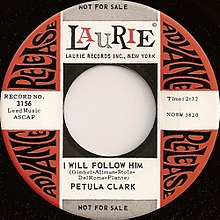Airplay
Airplay is a technical term from the music industry for playing a recorded sound carrier on the radio or a music video on television .
Word origin
Like many other names in the media operation was airplay from the English borrowed, with air (Engl., Of "to be on the air" be on the air ) is derived and play , meaning "to play" (Engl. Play , play ) is composed. It is therefore a real Anglicism .
History of origin
The spread of broadcasting, first in the USA , increasingly led to a program format from 1935 on which exclusively contained the presentation of records and tended to push back the costly live broadcasts. With the increasing sales of records, their topicality also gained in importance. In New York in 1935, a radio presenter began announcing records to the listener on the WNEW broadcaster as if a live broadcast was taking place; the idea of the "Make Believe Ballroom" was born. This format spread nationwide and from around 1940 the term record jockey or disc jockey was born for these radio announcers . With the emergence of hit parades as a measure of the topicality and classification of records, the program format on the radio was based on these yardsticks, the Top40 radio was created from 1953 . The number 40 goes back to the capacity of jukeboxes in the early 1950s, which contained a maximum of 40 singles. Since only the charts were played and no other contributions made it into the program, it was a special interest program . For this purpose, the playlists , i.e. the lists of the sound carriers to be played in the program to be created for copyright reasons before the broadcast, were strictly based on the Billboard charts. These program formats have spread worldwide on radio. From July 4, 1970, the American Top 40 (abbreviated AT40), founded and initially moderated by Casey Kasem , began broadcasting weekly nationwide on the basis of the Billboard hit parades.
impact

For the record industry today, airplay is one of the most important ways to promote its products; unlike active advertising, it's even free. Since the beginning of airplay, special free sound carriers have been produced for broadcasting, which are labeled as not for sale. The airplay specifically reaches those groups of listeners who are also potential buyers for sound carriers. The need is thus awakened by acoustic perception, with television (for example music channels such as MTV or VIVA ) also by optical perception.
Airplay plays a very important role in getting the charts up in most countries. The frequency with which a piece of music is played by the broadcaster flows into the US Billboard charts and other hit parades around the world as one of several survey sources. Billboard released specific charts, titled Most Played in Juke Boxes and Most Played by Jockeys , listing the hits most played in jukeboxes and on the radio. The former were discontinued from October 28, 1957, the latter from July 28, 1958. Special methods used by the broadcasters, known as rotation , enable the same music track to be used in the program with different frequencies, without the listener perceiving it as annoying. The intensity of the airplay of a certain sound carrier thus also influences its placement in the hit parade and vice versa - there is a build-up of mutually reinforcing effects.
A common but illegal practice of getting as much airplay as possible was and is Payola . This involves bribery of editors or radio hosts by the industry. The inclusion of airplay as transmission quotas is a disadvantage for the charts. The managers within the music industry assume that the US Billboard charts below number 40 no longer provide any information about the actual sales figures.
outlook
The importance of Top40 stations, the so-called Top40 radios , whose music selection is limited to hit parade songs, has decreased significantly. In the USA in 1993 the share of the top 40 radio stations in a total of 9,890 radio stations was only 4.5%, in 1992 the top 40 stations were still 5.8% of all stations. The reason is on the one hand the specialization of the program formats on certain styles, there are country radio , rock or oldie stations. On the other hand, other media such as Internet radio or online shopping platforms have contributed to the diversification of the media. Nevertheless, airplay in the current charts continues to occupy an important part of radio and television programming worldwide.
Individual evidence
- ^ A b Peter Wicke and Wieland & Kai-Erik Ziegenrücker: Handbook of popular music , Mainz 2007, p. 25. ISBN 978-3-7957-0571-8
- ↑ Ben Fong-Torres: The Hits Just Keep On Coming: The History of Top40 Radio. 2001, p. 19.
- ↑ Ben Fong-Torres: The Hits Just Keep On Coming: The History of Top40 Radio. 2001, p. 20.
- ^ Harvey Rachlin: The Encyclopedia of the Music Business. 1981, p. 419.
- ^ Harvey Rachlin: The Encyclopedia of the Music Business. 1981, p. 312.
- ↑ William Knoedelseder: hits and the backers - machinations Musikbusineß , Verlag Ullstein, Frankfurt / M. - Berlin 1994, p. 169. ISBN 3-550-06856-5
- ↑ Ben Fong-Torres: The Hits Just Keep On Coming: The History of Top40 Radio. 2001, p. 245.